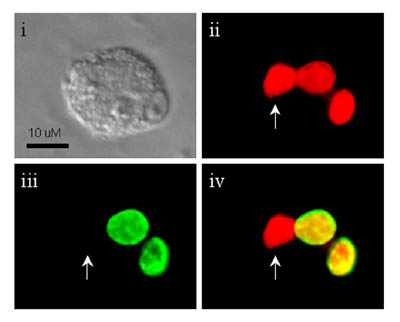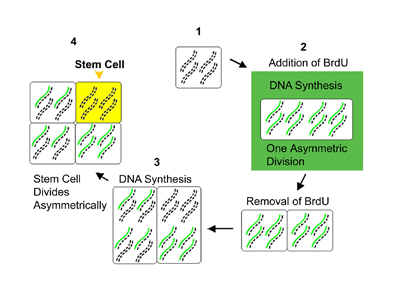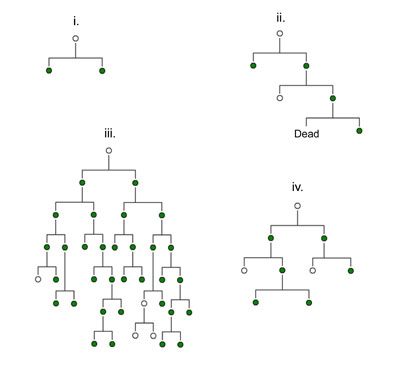Asymetrical Division
We are interested in characterizing the specific cell lineages involved in the development of the mammalian brain. The mammalian forebrain contains neural stem cells that can proliferate to produce cells with multiple cellular and spatial phenotypes and that are capable of long term self-renewal (over the lifetime of the animal). In studying the earliest origin of these neural stem cells in the embryo, we have been led by our data to test the hypothesis that the default state for mouse embryonic stem cells is to become neural stem cells. Mouse embryonic stem (ES) cells are lines of pluripotent early blastocyst cells that can give rise in vivo to entire and completely viable mice. In vitro in the presence of serum these ES cells will form aggregates called embryoid bodies containing cells that differentiate into blood, neural, muscle and other cell types In contrast to these differentiating ES cell aggregates (embryoid bodies), however, we found that when cultured under serum-free, low cell density conditions, a small (but quantitatively reliable) percentage (0.2%) of single ES cells proliferate in the presence of leukemia inhibitory factor (LIF) to form floating sphere colonies of cells that express the neuroepithelial marker nestin, but no longer express the ES cell markers Oct4 and SSEA1.

The above image shows brightfield and fluorescence (and merge)
photographs of one of the lineages (lineage 2). the brdu is shown in green,
histone in red (a nuclear counterstain) and the merge shows both
colocalized in yellow color. **Photo credit: Phillip Karpowicz**

The above table is a schematic of the brdu labeling
strategy we used to demonstrate immortal strand cosegregation under a real
time imaging system. **Provided by: Phillip Karpowicz**

The above is a set of 4 reconstructed lineages showing the ancestry
of labeled (green) and unlabeled (white) cells in clones imaged under the
system. lineage 2 is the same clone that is photographed in (2). **Provided by: Phillip Karpowicz**
Related Publications
Karpowicz, P., Pellikka, M., Chea, E., Godt, D., Tepass, U., and van der Kooy, D. The germline stem cells of Drosophila melanogaster partition DNA non-randomly. European Journal of Cell Biology. 88 (2009) 397-408. (karpowicz...2009)
Karpowicz P, Morshead C, Kam A, Jervis E, Ramunas J, Cheng V, van der Kooy D. Support for the immortal strand hypothesis: neural stem cells partition DNA asymmetrically in vitro. Journal of Cell Biology 170 (2005) 721-32. (karpowicz...2005...)
**photo credit: Sandrine Willaime-Morawek**
